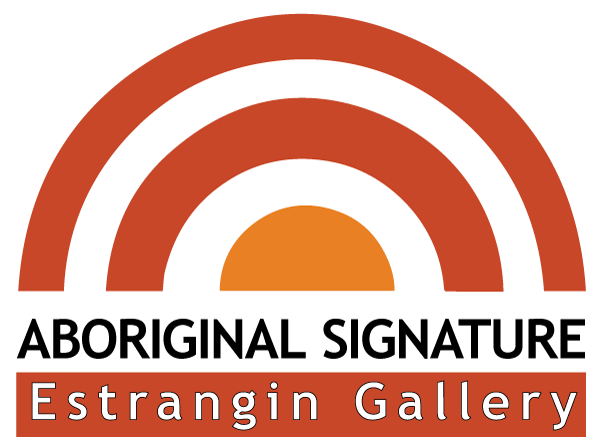by Natalie McCarthy, studio coordinator at Mangkaja Arts, June 2020
As Studio coordinator, I have only been working with Mangkaja artists for two years, a short time in the history of MARA. The magic that happens in the studio is remarkable but can be a daily occurrence. Seeing a work unfold before my very eyes, there are no real words to describe that feeling, the buzz. Or when an artist such as Eva Nargoodah brings in a work you know they have laboured over for many weeks, even months in between juggling family life and grand kids.
Peinture Aborigène et gravure sur place de métal de l’artiste Ngarralja Tommy May - JILJI AND BILA - 60 x 60 cm - 340/19
There it is, just like a miracle. In the forefront is Mangkaja’s former Chair, founding member and one of the last remaining Rainmakers, Senior Law man Ngarralja Tommy May. He would usually come into the studio every day, except for the last few months because we have had to close due to the Corona Virus pandemic, which has been difficult for him. Tommy began his working career as a stockman, taking him through the western and central desert regions and as far north as Arnhem Land, learning many of the dialects on the way. Since he began doing art, things have changed a lot for Tommy, except for the travel bit. Not only including most of Australia, Tommy has travelled the world over, recently returning from New York Outsider Art Fair earlier in January 2020. He says," It's my job and it's a good job" because he gets to travel everywhere and try different things. "And now I've even done fashion" referring to the successful collaboration with Australian fashion house Gorman that happened last year. Tommy is highly regarded for his distinguished printmaking skills, which have provided the foundation and a natural progression for the development of his etchings onto tin works. He has also experimented with digital animation, jewellery and is an innovator with his art practice in general. Kurtal 2019 uses pens and markers normally used by graffiti and street artists to tell the ceremonial story of Kurtal digging the Jila and bringing the rain.
Peinture Aborigène de l’artiste Sonia Kurarra - MARTUWARRA - 240 x 120 cm - 182/19.
Sonia Kurarra is also an artist who would work every day, all day if you let her. Her stream of consciousness mark making enables her to recreate again and again her fond memories of growing up by the Fitzroy River. Immersing herself and the viewer in painterly-layered renditions of the flora and fauna that exist there and even created it. Sonia was the first to try her hand on Perspex after picking up a discarded piece in the studio to work on and has taken the medium to new levels, leading the way for her sister Mrs Japulija (dec.2020) and the rest of the Mangkaja senior artists to try. Around the time Sonia and Mrs Japulija produced the Perspex works included in this show they also collaborated together on the most ambitious Perspex installation to date, producing six panels reaching three metres high, of double sided transparent work, hung from the ceiling and causing a sensation at the MCA Sydney as part of The National March 2019. Mrs Japulija’s Billabongs 2019, as seen in 36th NATSIAA can also be viewed from front and back. The transparency shows the subtle structured layers she created with grids and circles to represent the billabong country of the Fitzroy Valley after flood time and looks completely different on each side. One of her last works to be created on the Perspex medium.
Peinture Aborigène de l’artiste Rosie King Tarku - Desert From The Air - 120 x 120 cm - 20/20
When Rosie Tarco King enters the studio she will announce, "I've walked a long way I have, I walked a long way me". She is not referring to the aged care facility where she now lives but the desert she walked out of as a young woman in the 60’s, one of the last nomads of the area. A long- time member of Mangkaja, Rosie has had a remarkable explosion in paint lately to create these new paintings that recall the landmarks and maps of country she travelled across in the Great Sandy Desert.It’s been quiet in the studio since we have had to close with Corona-19 restrictions and there have been a lot of adjustments to continue supporting the artists and allow them to keep doing what they do best, making art whilst keeping them safe.Since last year and just recently we have sadly lost two more of the artists included in the show. With personal stories that show great resilience and survival, their art connects us to place and keeps it alive for generations to come. The strength and confidence to which MARA artists have made their mark up until today leaves a conscious space for the younger artists to come through and try their hand at painting, perspex, tin, jewellery, fashion or something new.















